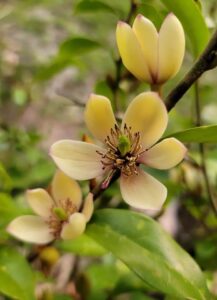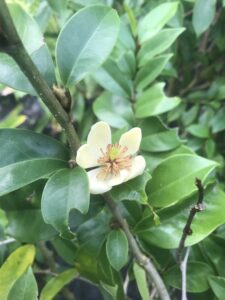Banana Shrub
for Northeast Florida,
Jacksonville | St. Augustine area Landscapes
(Magnolia figo; formerly Michelia figo)
Origins and Best Use of Banana Shrub / Magnolia Figo for the Northeast Florida Jacksonville | St. Augustine area home Landscape:

– Banana Shrubs is an evergreen tree in the magnolia family, native to China, Banana shrubs were introduced into the US from Southeastern China in 1789. They are a great Florida friendly addition to the landscape with excellent fragrant flowers that smell exactly like bananas! If you are attempting to create a fragrant garden, don’t miss this one, its truly fantastic!
– Banana Shrub is used in Shanghai, China, as a tall evergreen hedge. It is known to grow to a large evergreen compact tree. It is cultivated here as an ornamental plant in gardens for its extremely unique fragrant flowers. They are cold tolerant to 32 degrees so you may want to cover them during a hard freeze.
– Excellent Fragrance, banana shrubs can be planted near an entryway or window so that its fragrance can be enjoyed. The plants tend to be slow growing with a rounded, open habit.
– Great as an ornamental flowering tree for a smaller scale tree that doesnt shade out the entire lawn.
– can be used in hedge screen, if kept pruned.
– Attracts pollinators to the garden
A bit of an explanation with the recent name change:
– Originally described by Portuguese naturalist João de Loureiro as Liriodendron figo, it was reclassified as Michelia figo by German botanist Curt Polycarp Joachim Sprengel. However a cladistic analysis (a scientific method of reconstructing the evolutionary trees of plants ) of the genus Michelia found them to lie within the genus Magnolia, giving them the new binomial name of Magnolia figo.
Foliage of the Banana Shrub / Magnolia Figo:
– The plant is evergreen and has glossy, deep green leaves that are three inches long. The buds and immature leaves often have a covering of brown fuzz that the leaves lose as they mature.
– Adds texture to the garden and contrasts well with smaller foliage plants., making it a great backdrop for other garden plants.
– Foliage is cold tolerant to 32 degrees and will quickly regrow from its roots or stems the following spring in the Jacksonville and St. Augustine area gardens.
– As with all sub tropical plant selections, they are particularly responsive to their individual planting location. When planted on the south side of the house away from north winds, or where receiving some frost protection from larger trees or nearby buildings. you may get only foliar damage. If planted into open exposed areas in full sun you may get leaf and stem damage. If in a protected area you may get no damage at all. Utilize your yards frost free microclimates for all of your tropical and subtropical plant selections.
Blooms of the Banana Shrub / Magnolia Figo:
– Blooms during spring and fall are really quite beautiful much like tiny little magnolia blooms that are extremely fragrant. These really do have to be smelled to be believed, they smell like a sweet banana!
Preferred Exposure for Banana Shrub / Magnolia Figo :
– Banana shrub will grow in either sun or light shade. Shaded plants grow taller than sun grown plants and develop a central leader with little pruning; whereas, sun grown plants often will have a shorter , tighter form and the leaves will be more yellowish green, developing several trunks with a
rounded to vase-shaped canopy.
In Northeast Florida, a plant receiving 6 hours or more of sun exposure is considered to be planted in a full sun location. Morning shade and afternoon sun is also ideal, or filtered light under taller growing shade trees. Plants will bloom less in lower light areas but may be better protected from damaging winter frosts in those same shadier locations.
– Best if planted on the south side of the house away from cold north winds,
up next to a fence or near the foundation of a home or other building, or near larger shade trees that will protect these tropical plants from frost. Or plant on the west side of a home or building.

Soil Preference / Salt tolerance of the Banana Shrub:
– The plant prefers well-drained, fertile, sandy, and slightly acidic soil that has high organic matter content. Amend with compost when planting into dry sandy soils.
– Banana Shrubs can be grown in a variety of soil types, including quite heave, clay substrates and loam soil.
– slightly salt tolerant
Size and Growth of the Magnolia figo /Banana Shrub:
Size: The Banana shrub plant can reach heights of 10-15 ft ft in height and 10 ft in width if left unpruned to grow up as a small scale ornamental tree . Although these plants respond well to harsh prunings allowing them to be utilized as hedges, they make a stunning ornamental flowering tree.
I have utilized them in my home landscape as a foundation planting on the west side of my off grade foundation and keep them trimmed at about 4 ft height and 2 ft width with ease. I simply trim during the active summer growth period 4-6 inches beneath where I want to see them be for the rest of the year.
Growth Habit: Rather upright or cylindrical shaped when trimmed and when young rounding out to form a small rounded canopy with age and when allowed to grow untrimmed as an ornamental accent tree.
Growth Rate: Slow growing shrub, expect approximately 6 inches of growth annually in the first few seasons and 6-12inches annually once established.
Water Requirements of the Magnolia figo / Banana Shrub:
– Once established these plants require less frequent watering but are not highly drought resistant and should be given supplemental irrigations during droughts. Although much more durable once established in the landscape, regular water is necessary to get the plant rooted and growing on its own after being planted in the ground from an S & J Nursery container.
I have successfully grown these plants in both shaded areas with soil that stays continuously moist and in sandy soils in higher light locations, for me these are not picky about soils conditions.
Care of the Banana Shrub / Magnolia figo in the Northeast Florida Landscape:
– Amend sandy soils generously with compost to help your Banana Shrub plants get established quickly.
Here is a link to S & J Tree Farm and Nurseries Guide to Planting Your Plants into their New Home
– Water every day during the establishment period after planting in the garden from an S & J Nursery container. Be sure to continue supplemental irrigation during the hot summer months during prolonged droughts. Here is a link for S & J Tree Farm and Nurserys information on how to water your newly installed plantings in the Northeast Florida landscape
– Fertilize each year just after trimming in the spring after a cold recovery or in summer with a good shovel full of garden compost or use Osmocote or another slow release plant food spring, summer and fall.
– When temperatures drop under 32 degrees you may opt to protect your foliage and or stems from severe frost damage by throwing a blanket or other breathable fabric over the top of the plant making sure the edges touch the ground to trap in the heat from the soil.
– Make your last summer pruning in August giving your Banana shrub plant ample time to recover new foliage that will harden off before winter arrives for us here in late December. Pruning too late into the fall will cause flushes of cold sensitive new growth that is sure to freeze during even a light frost that hardened off foliage would not be affected by.
– DO NOT REMOVE WINTER BURNT FOLIAGE UNTIL ALL DANGER OF FROST HAS PASSED. Be sure not to remove any stems or leaves from the plant until we have reached the last average frost date and there are no late freezes being predicted. ( mid February for Northeast Florida is the average last frost date) Trimming burnt foliage and stems before then will leave bare branches deeper on the plant exposed to cold temperatures that would have been protected by those same stems and foliage if left unpruned and most often results in loss of the plant entirely.

